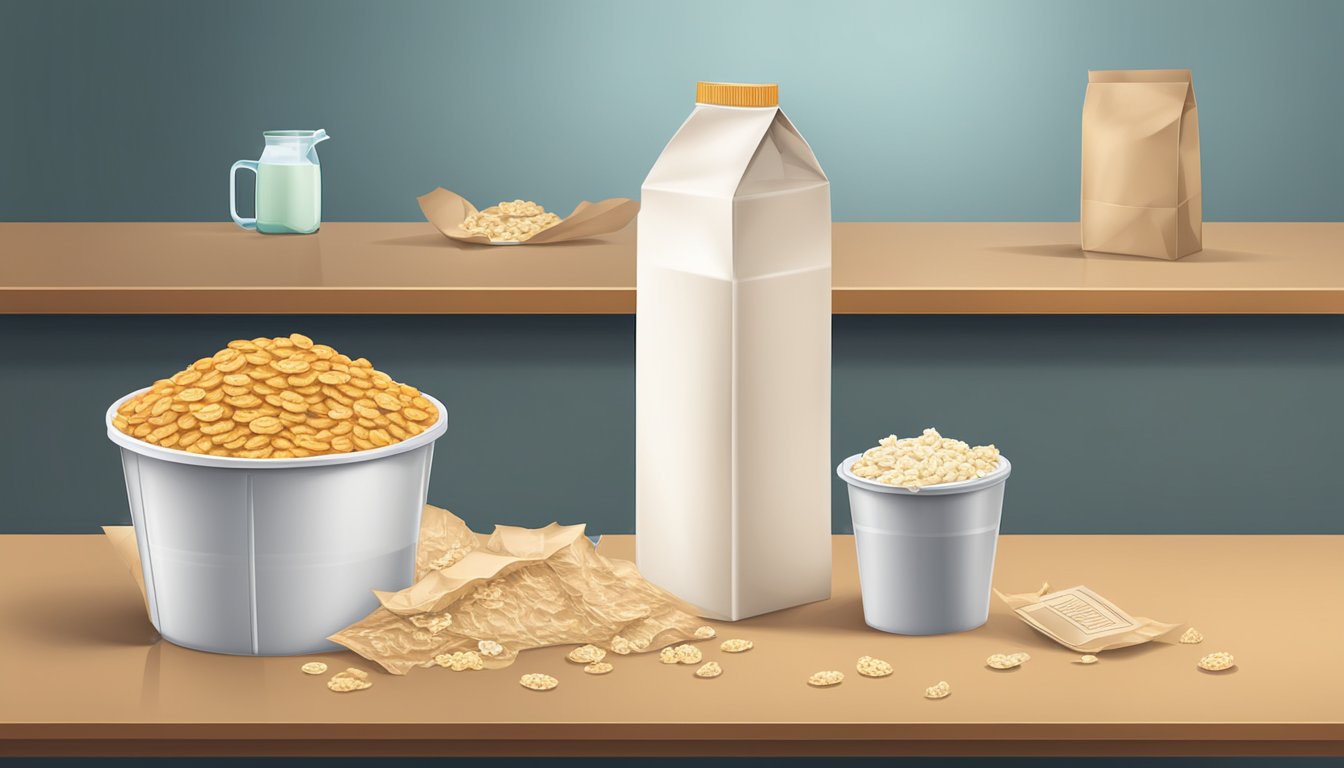Jack in the Box, a popular fast-food chain, serves millions of breakfast meals annually. The packaging used for these meals has a significant environmental impact that warrants examination. From disposable cups to sandwich wrappers, the materials used contribute to waste and pollution.
Jack in the Box currently lacks a public goal or policy for sustainable packaging, exposing the company to potential risks. This absence of clear environmental commitments sets them apart from some competitors who have made strides in this area. The fast-food industry’s reliance on single-use packaging has long been a concern for environmentalists and conscious consumers.
While paper packaging is often seen as a more eco-friendly option, it comes with its own set of environmental challenges. These include high water and energy usage during production, as well as potential contributions to deforestation. As consumers become more aware of these issues, there is growing pressure on companies like Jack in the Box to address their packaging practices and seek more sustainable alternatives.
Understanding the Food Packaging Problem

Food packaging plays a crucial role in protecting and preserving food products. However, its widespread use has significant environmental consequences. The food industry relies heavily on packaging materials, which contribute to waste generation and resource depletion.
Prevalence in the Food Industry
Packaging is ubiquitous in the food industry. Nearly every food product on store shelves comes in some form of packaging. Common materials include plastics, glass, metal, and paper.
Single-use packaging is especially prevalent. Items like individually wrapped snacks, single-serve containers, and disposable beverage bottles are designed for convenience but lead to increased waste.
The EPA reports that food and packaging materials constitute almost half of all municipal solid waste in the United States. This highlights the scale of packaging use in the food sector.
Packaging and the Environment
Food packaging has several environmental impacts:
- Waste generation: Most packaging ends up in landfills or as litter
- Resource depletion: Production requires raw materials and energy
- Pollution: Manufacturing processes can release harmful emissions
- Carbon footprint: Packaging contributes to greenhouse gas emissions
Plastic packaging is particularly problematic due to its persistence in the environment. It can take hundreds of years to decompose, harming ecosystems and wildlife.
However, packaging also plays a role in reducing food waste, which is another significant environmental concern. Proper packaging extends shelf life and protects food from contamination.
Jack’s Role in Environmental Stewardship

Jack in the Box demonstrates a commitment to environmental stewardship through corporate initiatives and philanthropic efforts. The company aims to balance business operations with ecological responsibility.
Corporate Responsibility
Jack in the Box takes its environmental impact seriously. As of September 2024, 52.84% of the company’s food packaging spend went towards compostable materials. In 2023, Jack in the Box eliminated PFAs from all packaging systemwide, showcasing a dedication to safer, more sustainable options.
The company faces pressure from shareholders to address packaging-related risks. In a notable vote, 95% of shareholders expressed concern about the environmental impacts of Jack in the Box’s packaging footprint.
Jack in the Box continually seeks ways to improve its sustainability practices. The company focuses on reducing plastic use and exploring alternatives to traditional paper packaging, which can have negative environmental consequences.
Jack in the Box Foundation
The Jack in the Box Foundation plays a key role in the company’s community engagement efforts. While specific environmental initiatives are not publicly detailed, the foundation’s work aligns with Jack in the Box’s broader commitment to social responsibility.
The foundation primarily focuses on addressing childhood hunger. It partners with organizations like No Kid Hungry to provide meals to children in need. This focus indirectly supports environmental goals by promoting food security and reducing waste.
Through its foundation, Jack in the Box engages stakeholders and demonstrates a commitment to making a positive impact beyond its core business operations.
Assessing the Supply Chain

Jack’s breakfast packaging involves a complex network of suppliers and processes. Evaluating the supply chain reveals opportunities for reducing environmental impact while maintaining food quality.
Suppliers and Food Quality
Jack sources ingredients from multiple suppliers across the country. Eggs come from cage-free farms in Iowa. Bacon is sourced from pork producers in North Carolina. Bread arrives from bakeries in Illinois.
Each supplier adheres to strict food safety standards. Regular audits ensure compliance with quality control measures. Temperature-controlled trucks transport perishable items to maintain freshness.
Jack prioritizes local sourcing when possible to reduce transportation emissions. The company has established long-term partnerships with key suppliers to promote consistency and trust.
Sustainable Practices
Jack implemented several initiatives to improve supply chain sustainability:
- Reduced packaging waste by 15% through redesigned shipping containers
- Transitioned 30% of truck fleet to electric vehicles
- Installed solar panels at 5 major distribution centers
- Implemented water recycling systems at food processing facilities
Suppliers are encouraged to adopt eco-friendly practices. Jack offers incentives for meeting sustainability targets. The company hosts an annual summit to share best practices among partners.
Jack tracks key metrics like carbon emissions, water usage, and waste production across the supply chain. This data guides ongoing improvement efforts.
Direct Impact on the Environment

Jack’s breakfast packaging contributes to environmental challenges through waste generation and resource consumption. The materials used and production processes have measurable effects on ecosystems and natural resources.
Waste Management Strategies
Jack’s packaging waste ends up in landfills, recycling facilities, or as litter. Plastic wrappers and containers can take hundreds of years to decompose. Paper-based packaging breaks down faster but still contributes to landfill volume.
Recycling helps mitigate these issues. Many of Jack’s cardboard boxes and plastic bottles are recyclable. However, contaminated food packaging often can’t be recycled.
Some Jack’s locations have implemented composting programs for food scraps and compostable packaging. This diverts waste from landfills and produces useful soil amendments.
Resource Consumption and Energy Usage
Producing Jack’s packaging requires raw materials like wood pulp, petroleum, and minerals. Extracting and processing these materials impacts forests, water sources, and habitats.
Manufacturing packaging is energy-intensive. Processes like plastic molding and paper milling consume significant electricity and fuel. This contributes to greenhouse gas emissions and air pollution.
Transportation of packaging materials and finished products also uses energy and creates emissions. Jack’s supply chain relies on trucks and ships that burn fossil fuels.
Water usage is another concern. Paper production in particular requires large amounts of water, potentially straining local water supplies near packaging plants.
Packaging and Public Health Concerns

Food packaging plays a crucial role in ensuring public health and safety. It protects products from contamination and helps maintain freshness. However, certain packaging materials can also pose potential risks if not properly managed.
Food Safety and HACCP
Food safety is paramount in the packaging industry. HACCP (Hazard Analysis Critical Control Points) is a systematic approach used to identify and control potential hazards. It involves analyzing each step of the food production process, from packaging to distribution.
Packaging materials must meet strict safety standards to prevent chemical leaching. This is especially important for items that come into direct contact with food. Regular testing and quality control measures are essential to maintain compliance.
Proper packaging also helps prevent cross-contamination during transport and storage. It acts as a barrier against external contaminants, preserving the integrity of the food product. Temperature-controlled packaging is crucial for perishable items to prevent bacterial growth.
Promoting Food Safety in Packaging
Innovative packaging designs can actively promote food safety. Some materials incorporate antimicrobial properties to inhibit the growth of harmful microorganisms. These technologies help extend shelf life and reduce the risk of foodborne illnesses.
Clear labeling on packaging is essential for consumer safety. It should include allergen information, nutritional content, and proper storage instructions. Tamper-evident seals provide an additional layer of security, ensuring the product hasn’t been compromised.
Packaging manufacturers must adhere to Good Manufacturing Practices (GMP) to maintain hygiene standards. This includes regular sanitation of equipment and proper training of personnel involved in the packaging process. Traceability systems in packaging help quickly identify and recall potentially unsafe products if issues arise.
Breakfast Items Analysis

Jack’s breakfast packaging has varying environmental impacts depending on the specific products and materials used. Analyzing individual items reveals opportunities for sustainability improvements across the menu.
Impact of Specific Breakfast Products
Orange juice packaging contributes 13-35% of the product’s carbon footprint. Single-serve cereal boxes have a higher environmental impact than larger sizes. Bread buns in individual wrappers account for 17% of their total carbon emissions.
Peanut butter jars show significant differences in greenhouse gas emissions based on container size and brand. Larger containers generally have a lower per-serving impact.
Coffee cups and lids remain a major source of food waste and packaging-related emissions for breakfast items. Disposable utensils add to the environmental burden of to-go orders.
Improving Packaging Standards
Jack’s can reduce its breakfast packaging footprint by optimizing container sizes and materials. Switching to post-consumer recycled plastics for juice bottles and utensils cuts virgin resource use.
Offering reusable mug incentives encourages customers to bring their own containers. Compostable or recyclable coffee cup alternatives minimize landfill waste.
Transitioning to bulk cereal dispensers allows customers to use their own containers. This eliminates single-serve box waste. Implementing a packaging return program for items like peanut butter jars promotes circular economy principles.
Standardizing recycling labels across all breakfast packaging improves proper disposal rates. Partnering with local composting facilities ensures food scraps and compostable items are properly processed.
Consumer Engagement and Education

Jack’s Breakfast actively involves customers in sustainability efforts through its loyalty program and educational initiatives. The company fosters a culture of environmental responsibility among patrons and staff alike.
Loyalty Program and Customer Awareness
Jack’s Breakfast rewards eco-conscious choices through its Green Points loyalty program. Customers earn points for bringing reusable containers or opting for minimal packaging. The program’s app provides tips on reducing waste and highlights the environmental impact of packaging choices.
In-store displays showcase the lifecycle of packaging materials, from production to disposal. These visuals educate customers on the importance of sustainable options. Jack’s also partners with local schools to offer workshops on eco-friendly practices, extending its educational reach beyond the restaurant.
Building a Culture of Sustainability
Jack’s Breakfast trains staff extensively on sustainability practices. Employees learn to guide customers toward greener choices without being pushy. The company celebrates diversity by incorporating sustainability practices from various cultures into its operations.
Regular sustainability challenges engage both staff and customers. These events promote creative solutions for reducing packaging waste. Jack’s also hosts community clean-up days, fostering a sense of shared responsibility for the environment.
The restaurant’s website features a sustainability blog, sharing success stories and new initiatives. This transparency builds trust and encourages customer participation in eco-friendly efforts.
Evaluating the Big Picture

Jack’s breakfast packaging impacts the environment through its carbon footprint and long-term sustainability. The restaurant industry faces challenges in balancing convenience with ecological responsibility.
Overall Carbon Footprint
Jack’s breakfast packaging contributes to the company’s total carbon emissions. The materials used, manufacturing processes, and disposal methods all factor into this footprint. Single-use plastics and foam containers have a higher environmental cost compared to recyclable or compostable alternatives.
Paper-based packaging, while often seen as more eco-friendly, still requires resources and energy to produce. Jack’s must consider the entire lifecycle of its packaging, from raw material extraction to end-of-life disposal.
Transportation of packaging materials to restaurants and waste management after use also add to the carbon footprint. Jack’s can reduce its impact by sourcing materials locally and optimizing delivery routes.
Long-Term Goals and Visions
Jack’s aims to improve its environmental performance over time. The company has set targets to increase the use of sustainable packaging materials in its breakfast offerings. This includes exploring biodegradable options and reducing overall packaging waste.
Investing in research and development of innovative packaging solutions is crucial. Jack’s is working with suppliers to create materials that maintain food quality while minimizing environmental harm.
Education plays a key role in Jack’s long-term vision. The company plans to inform customers about proper disposal methods and the importance of recycling. Collaborating with local recycling facilities can enhance these efforts.
Jack’s is also considering a packaging return program, where customers can bring back certain containers for reuse or proper recycling. This circular approach could significantly reduce waste and resource consumption.
Global Implications and Alternatives

Jack in the Box’s packaging choices have far-reaching effects beyond local markets. The food industry’s global nature means decisions made by one company can influence practices worldwide.
International Brands and Strategies
Major fast-food chains like McDonald’s and Burger King have implemented sustainable packaging initiatives in various countries. These efforts include using recycled materials, reducing plastic usage, and improving recyclability. In Australia, Hungry Jack’s (Burger King’s local brand) has replaced plastic straws with paper alternatives in over 400 restaurants.
Some international brands are testing reusable packaging systems. For example, certain European fast-food outlets now offer customers the option to return containers for cleaning and reuse. This circular model reduces waste and resource consumption.
Exploring Eco-Friendly Alternatives
Innovative materials are emerging as potential replacements for traditional fast-food packaging. Biodegradable containers made from plant-based sources like corn starch or sugarcane bagasse can break down more easily than petroleum-based plastics.
Edible packaging, such as seaweed-based wraps, offers another intriguing option. These materials eliminate waste entirely by allowing customers to consume the entire product.
Some companies are experimenting with minimal packaging approaches. “Naked” sandwiches served directly on reusable trays reduce single-use waste significantly.
Investing in consumer education about proper disposal methods can also improve recycling rates and reduce environmental impact, regardless of packaging material choice.




